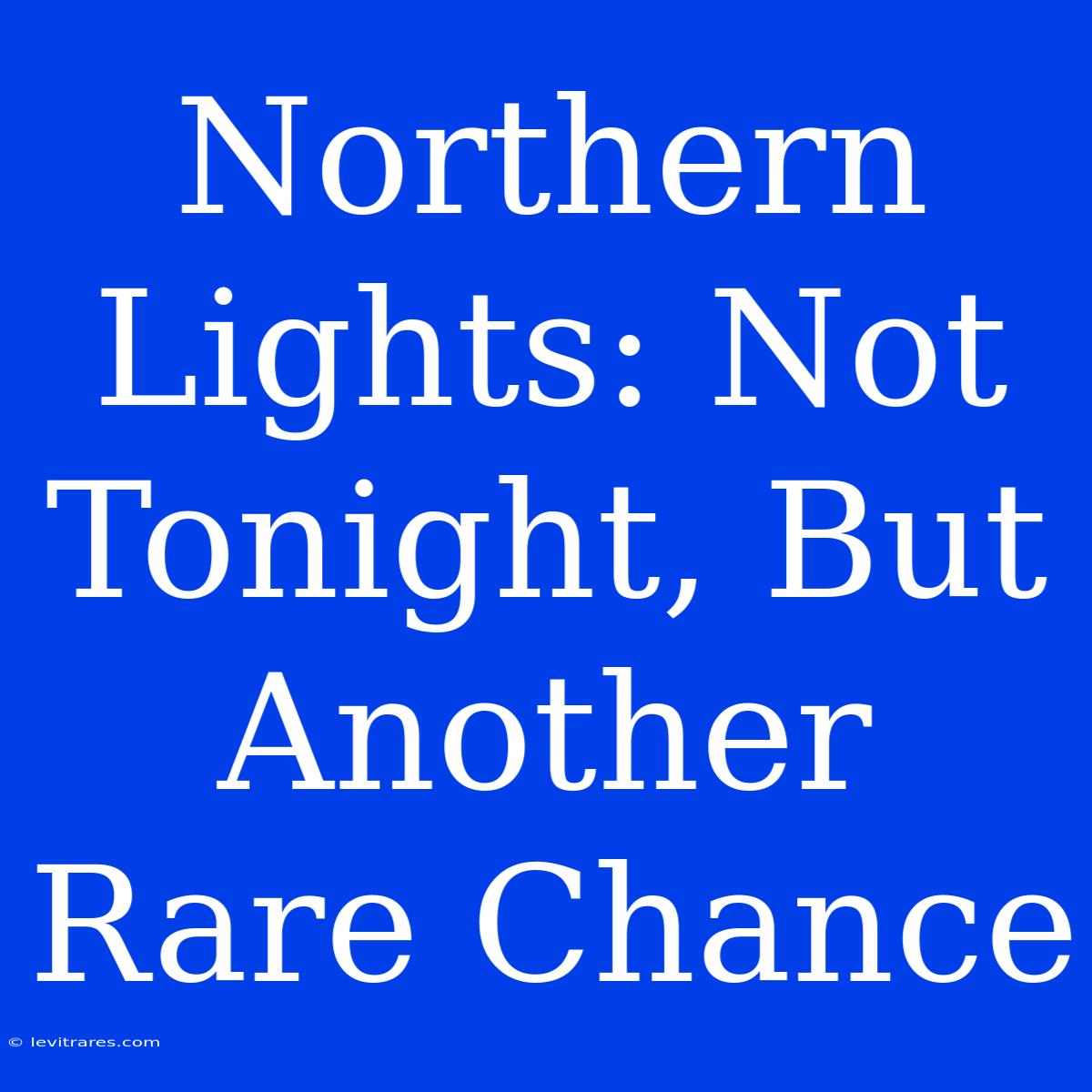Northern Lights: Not Tonight, But Another Rare Chance
Have you ever wondered what it would be like to see the Northern Lights? These celestial displays, also known as Aurora Borealis, are a breathtaking spectacle of nature, painting the night sky with vibrant colors. While the Northern Lights are a captivating phenomenon, they aren't a nightly occurrence. They are a rare and magical event.
Editor Note: This article explores the exciting, yet elusive Northern Lights, detailing the conditions that make them visible and offering insights into when you might get another chance to witness this natural wonder.
This article delves into the Northern Lights, outlining the conditions that make them visible and the best places to catch a glimpse. It explores the science behind this natural phenomenon, explains how to predict aurora activity, and offers practical tips to maximise your chances of seeing them.
Why are the Northern Lights so important? The Northern Lights are a reminder of the incredible power and beauty of our natural world. They are a testament to the interplay of solar activity, Earth's magnetic field, and atmospheric conditions. Observing this phenomenon can inspire a sense of awe and wonder, deepening our understanding and appreciation of the cosmos.
Analysis: This article is based on research from reputable scientific sources, including NASA and NOAA, as well as insights from experienced aurora chasers. It aims to demystify the Northern Lights, offering a comprehensive guide for anyone interested in witnessing this spectacular phenomenon.
Key Takeaways
| Aspect | Description |
|---|---|
| Solar Activity | Charged particles from the Sun, called solar wind, are a key driver of aurora activity. |
| Geomagnetic Storms | Intense solar activity can trigger geomagnetic storms, increasing the chances of strong auroras. |
| Location | Viewing the aurora borealis requires a dark location with clear skies, away from light pollution. |
| Timing | Aurora activity is typically higher around the equinoxes (March/September) and during periods of high solar activity. |
| Predicting Aurora Activity | Websites and apps provide real-time aurora forecasts, helping observers plan their viewing opportunities. |
Northern Lights: Unveiling the Spectacle
Aurora Borealis: This celestial display is a result of charged particles from the Sun interacting with Earth's atmosphere. As these particles collide with atmospheric gases, they excite the atoms, causing them to emit light, creating the mesmerizing auroral displays.
Key Aspects of Northern Lights:
- Solar Wind: The Sun continuously emits a stream of charged particles, known as solar wind.
- Geomagnetic Field: Earth's magnetic field acts as a shield, deflecting most of the solar wind.
- Auroral Ovals: The auroral ovals are regions around the Earth's magnetic poles where the auroras are most frequently seen.
- Auroral Colors: Different atmospheric gases emit different colors, creating a vibrant spectrum of light, ranging from green to red and purple.
Solar Wind: The Sun, a giant ball of plasma, constantly releases a stream of charged particles, called solar wind. This wind, carrying energy and momentum, travels through space at high speeds, reaching Earth and interacting with its magnetic field.
Geomagnetic Field: Earth's magnetic field acts as a protective shield, deflecting most of the solar wind. However, some charged particles from the solar wind can penetrate the magnetic field, particularly at the poles, where the field lines converge.
Auroral Ovals: The auroras are most commonly seen within two oval-shaped regions centered around Earth's magnetic poles, known as auroral ovals. These ovals are typically located at high latitudes, spanning across the northern and southern hemispheres.
Auroral Colors: The colors of the aurora are determined by the type of gas atoms that are excited by the charged particles. Green, the most common color, is produced by oxygen at lower altitudes, while red results from oxygen at higher altitudes. Nitrogen emits blue and purple colors.
Predicting Aurora Activity
- Geomagnetic Storms: Intense bursts of energy from the Sun, called coronal mass ejections (CMEs), can trigger geomagnetic storms, increasing the chances of strong auroras.
- Solar Cycle: The Sun's activity fluctuates in an 11-year cycle, with periods of high activity leading to more frequent auroras.
- Real-time Forecasts: Websites and apps, such as the NOAA Space Weather Prediction Center and the Aurora Forecast, provide real-time forecasts of auroral activity, helping observers plan their viewing opportunities.
The Hunt for the Northern Lights:
Location: Finding a location with minimal light pollution and clear skies is crucial for observing the Northern Lights.
Timing: Aurora activity is typically higher around the equinoxes (March/September) and during periods of high solar activity.
Practical Tips:
- Dress Warm: The Northern Lights are typically seen during the winter, so it's essential to dress warmly.
- Stay Patient: Aurora activity can vary, and it might take some time to witness a show.
- Capture the Moment: A camera with a long exposure setting can capture the faint colors and movement of the auroras.
Conclusion: Witnessing the Northern Lights is a truly awe-inspiring experience. Understanding the science behind this phenomenon and following practical tips can significantly increase your chances of witnessing this captivating celestial display. So, pack your bags, plan your trip, and get ready to be amazed by the beauty of the Northern Lights.

